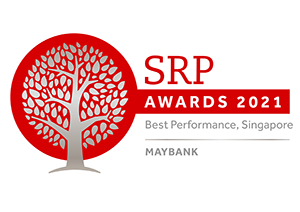Become a Premier Wealth Client with deposits and/or investments of S$300,000 or more with us.
Click here to get started with Maybank Premier >
Award Winning Structured Products

We are honoured to have won “Best Performance" for three consecutive years by the Structured Products & Derivatives Awards 2021.
Thank you for your continuous support, we will continue to innovate on our products and deliver superior wealth solutions #ForYou.
What are Structured Notes?
Structured Notes are financial instruments which return is linked to the performance of one or more underlying assets or benchmarks. These may include market indices, individual or baskets of stocks, bonds, commodities, currencies, interest rates, mutual funds or a mix of these. A coupon may be payable which is usually linked to the performance of the assets or benchmarks.
Structured Notes usually comprise of two components – Zero-coupon bond and option. The bond component aims to return your invested principal amount at maturity. The option is linked to the performance of your underlying asset(s) or benchmark(s). Depending if your investment view of your asset(s) or benchmark(s) is/are correct, you may or may not receive the coupon.
Common Types of Structured Notes
Equity Linked Note (ELN) / Knock-Out Equity Linked Note (KOELN)
• Short investment tenor of a month.
• Investor is able to express a short term neutral to mildly bullish view of the underlying asset.
Fixed Coupon Note (FCN)
• Investor is able to express a neutral to mildly bullish view of the underlying asset(s).
• Provide regular fixed coupon payments.
• Investment parameters can be tailored to the investor’s requirements.
Main Types of Underlying Assets

Equity-linked
Return may be linked to a single share, or a basket of shares, or to an equity index (e.g. the S&P) or a basket of indices. In some equity-linked Notes, the investor may receive shares instead of cash at the time when the principal is to be repaid.

Currency-linked
Return may be linked to a reference currency pair e.g. EUR/USD. In some payoffs, clients may receive the alternate currency instead of its base(original) currency.

Commodity-linked
Return or losses may be linked to a single or basket of commodities or indices.

Fund-linked
Return or losses may be linked to a single or basket of mutual fund.
Information is taken from moneysense.gov.sg.
Benefits of Structured Note Investments
Customisable and Diversification
Based on investors’ financial situations and needs, issuers can tailor Structured Notes to meet these requirements.
Ideal for investors looking for portfolio diversification in asset classes, sectors and geographies.
Potential Higher Returns
Structured Notes often offer investors potential returns that are higher than interest rates offered on traditional deposits. Some Structured Notes may even offer the potential for capital appreciation.
Benefit from various Market Views
Whether you are bullish, bearish or anticipating a range bound market, there are Structured Notes that can be used to generate positive returns.
Access New Markets and Instruments
With Structured Notes, you can access a broad range of investment instruments that traditionally require large capital investments or are only available to institutional investors.
How Can Structured Notes Meet Your Investment Objectives

Principal Preservation:
Principal Preservation products are designed with the objective to offer partial or full return of principal at Maturity together with potential returns.
Yield Enhancement:
The potential upside usually comes in the form of a receipt of coupon or purchasing a note at a discount.
Participation:
Participation products offer a return which would track the performance of one or more underlying asset.
Key Risks of Structured Notes Investments

Issuer Risk
If the issuer of the Structured Notes defaults on its commitments under the Structured Note, the investor risks losing his/her entire principal amount.

Principal/Capital Loss
If the underlying asset or benchmark underperforms, e.g. if the price, value or level of the underlying asset or benchmark does not move in the direction and/or by an amount sufficient to produce a return under the Structured Note.

Liquidity/Market Risk
By investing in a Structured Note, investors will have no access to their principal for the tenor of the Note. If investors wish to terminate the Notes, they are subject to the mark-to-market value and may incur some losses on the principal.
FAQ
Q: What do I need to consider if I want to buy a Structured Note?
A: You have to first assess your needs, goals, objectives, personal circumstances and risk profile.
Next, ensure that the structured note is in line with your investment views and objectives.
You will also need to understand the factors that will impact your returns as well as the risks involved in the product.
Q: What should I do if I’m interested in Structured Note?
A: Please contact your dedicated Premier Relationship Manager to find out more about our Structured Note investments.
If you are new to Maybank, do reach out to any staff in the branch to find out more.
Before engaging in over-the-counter transactions with or
through us, you should be aware of the risks which may be
involved in such trading, as well as some of our policies in
respect of such trading.
You should not enter into a transaction unless you fully
understand:
• The nature and fundamentals of the transaction and the
market underlying such transaction;
• The contractual relationship into which you are entering;
• The legal terms and conditions of the documentation for
such transaction;
• The nature and extent of the economic risk to which you
are exposed as a result of such transaction (and determine
that such risk is suitable for you in light of your specific
experience in relation to the specific transaction and your
financial objectives, circumstances and resources);
• The tenor, coupon, price, underlying asset or benchmark,
features and payoffs, settlement date, fixing date, maturity
date, and other terms material to the transaction;
• Any terms describing the risk factors, such as liquidity risk,
market risk, currency risk, issuer risk (in the event of issuer
default), and so on, including any condition(s) attached with
the securities, concerning voting rights or any other rights
and obligations for holders of the securities.
Warning: You may wish to seek advice from a licensed or an
exempt financial adviser before making a commitment to
purchase this product. In the event that you choose not to seek
advice from a licensed or an exempt financial adviser, you
should carefully consider whether this product is suitable for you.



